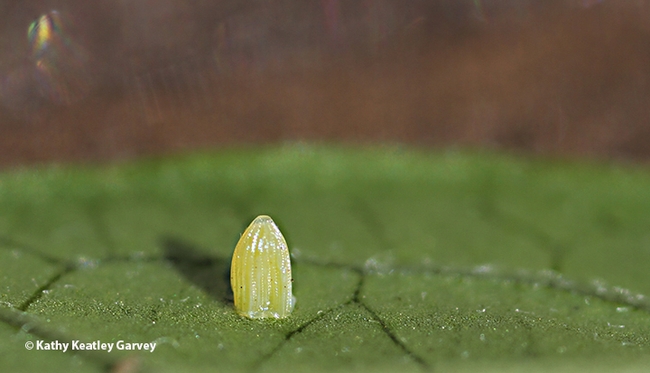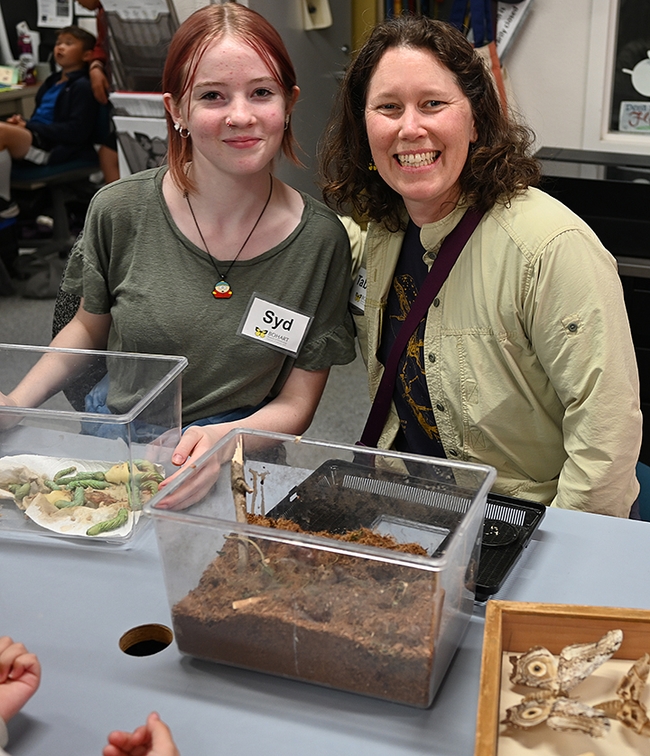- Author: Kathy Keatley Garvey
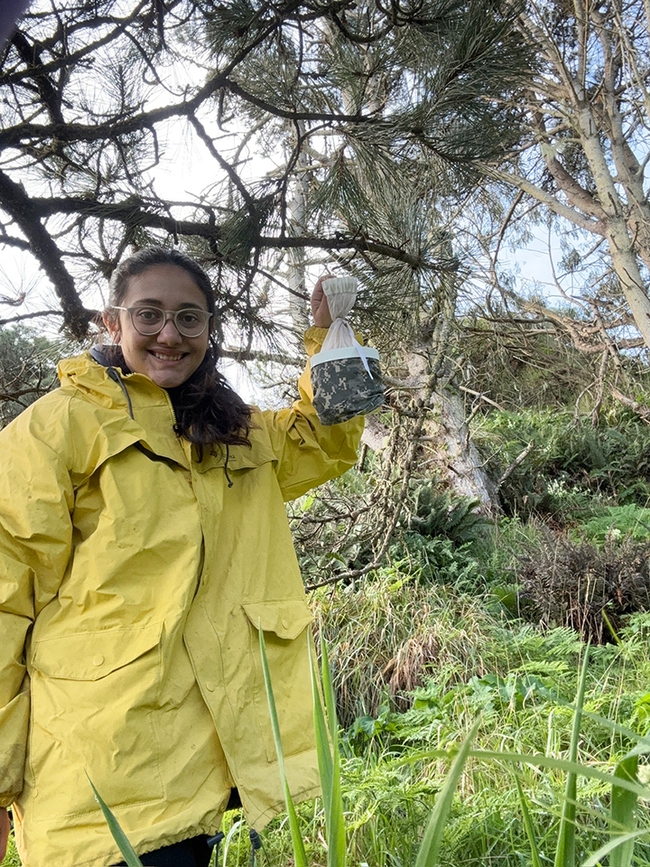
UC Davis doctoral student and medical entomologist Carla-Cristina “CC” Melo Edwards of the laboratory of medical entomologist-geneticist Geoffrey Attardo of the UC Davis Department of Entomology and Nematology, will be discussing mosquitoes and ticks--and how she traps them--when the Bohart Museum of Entomology hosts an open house on Saturday, Sept. 28.
Edwards will be among the scientists discussing and displaying their work and fielding questions.
The open house, themed "Museum ABCs: Arthropods, Bohart and Collecting," and free and family friendly, takes place from 1 to 4 p.m. in Room 1124 of the Academic Surge Building, 455 Crocker Lane, UC Davis campus. Parking is also free.
The event will be "an overview of terrestrial arthropods which encompasses everything from insects, arachnids, millipedes, isopods and centipedes," said Tabatha Yang, education and outreach coordination. "We will also showcase some of the trapping/catching methods we use, for example, nets, lights, pitfall traps and malaise traps."
"We also get asked a lot of questions about our own collection and why the specimens don't decay," Yang added. "We will highlight the different curation techniques from pinning, point mounting, preserving in alcohol and mounting on slides."
Edwards said she will discuss and showcase "different kinds of traps that we use for mosquitoes and ticks...Different types of mosquitoes require different types of traps!"
Her doctoral research focuses on investigating the physiological mechanisms underlying pyrethroid resistance in Aedes aegypti (the yellow fever mosquito). She was a McNair scholar at Baylor University, where she completed her undergraduate degree in cell and molecular biology in May 2021.
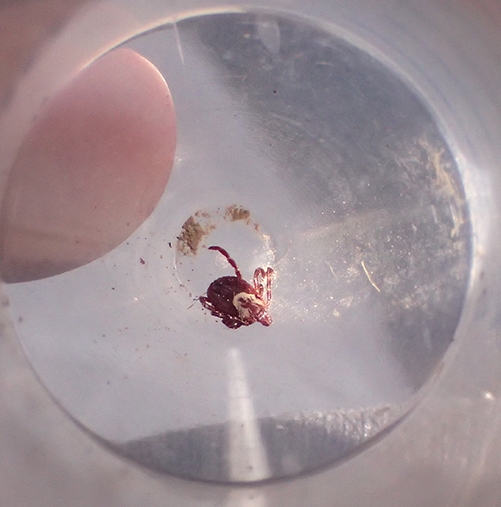
Luz Maria Robles, public information for the Sacramento-Yolo Mosquito and Vector Control, says the risk of contracting West Nile virus in Sacramento and Yolo counties continues. (See map of latest West Nile virus activity in the two counties.) This year, to date, the statistics show:
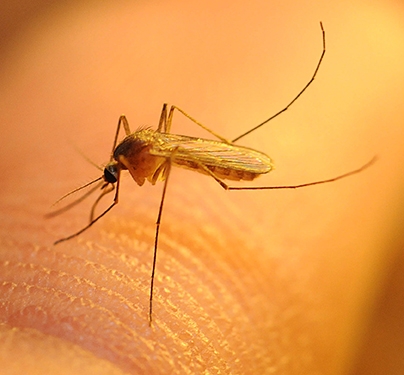
Yolo County: 1 dead bird and 42 mosquito samples have tested positive for West Nile virus
In addition to featuring the science of entomology, the Bohart open house will include a tribute to the late UC Davis professor Richard "Doc" Bohart (1913-2007), who founded the insect museum in 1946; served as the first director; and compiled 32 years on the UC Davis entomology faculty, Sept. 28 is his birthday anniversary and a cake to celebrate what would have been his 111th birthday will be served.
UC Davis distinguished emerita professor Lynn Kimsey, who directed the Bohart Museum for 34 years, retiring on Feb. 1, 2024, was Bohart's last graduate student. She remembers him in the audio of a newly produced video by Walter Leal, UC Davis distinguished professor of molecular and cellular biology and former chair of the UC Davis Department of Entomology. Kimsey provides the narrative and images. Leal added excerpts from a 1996 Aggie Video production when Kimsey interviewed Bohart. (See https://youtu.be/3YqnK-CpbJE)
The Bohart Museum is the home of a global collection of eight million insect specimens. It also houses a live petting zoo (Madagascar hissing cockroaches, walking sticks, tarantulas and more) and an insect-themed gift shop, stocked with t-shirts, hoodies, books, posters and jewelry, among other items. Director is Professor Jason Bond, the Evert and Marion Schlinger Endowed Chair, UC Davis Department of Entomology and Nematology, and associate dean, UC Davis College of Agricultural and Environmental Sciences.
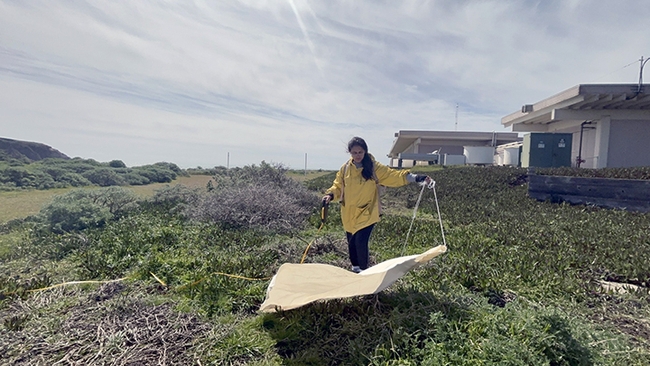
- Author: Kathy Keatley Garvey
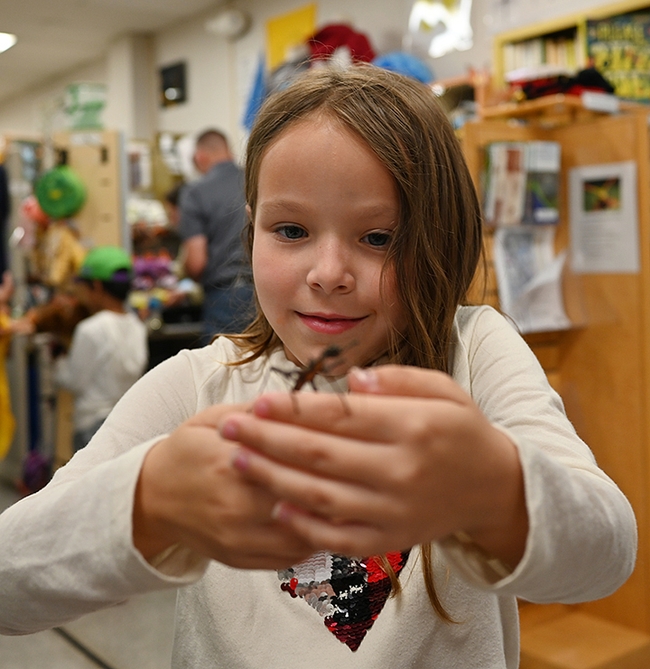
"For me, at least a lot of my interest developed when my parents gave me a net and a butterfly picture book and then gave me enough independence to explore on my own," recalls UC Davis distinguished professor emerita Lynn Kimsey, who served 34 years as director of the Bohart Museum of Entomology before stepping down on Feb. 1.
"Today parents seem to schedule every minute of their kid's day with scheduled activities," Kimsey said, "and this simply doesn't allow kids to explore, and use their imaginations."
So true. Kids are naturally curious. When they see lady beetles, aka ladybugs, they check out what they're doing, what they're eating (a menu of aphids and other soft-bodied insects), and how they take flight.
You can ask them questions: What do you think that is? What is it doing? Can you describe it? Do you want it to be your friend? Why or why not? Do you want to write a poem about it? Do you want to photograph it?
They quickly learn that everything eats in the garden. They can watch a honey bee foraging for nectar and pollen, and then get nailed by a praying mantis. Ditto the butterfly. One minute a butterfly is sipping nectar, and the next minute, it's snared in a spider web.
And they never forget metamorphosis: how a butterfly egg magically transforms into a caterpillar, the caterpillar into a chrysalis, and then an adult butterfly ecloses from that chrysalis. "Magic" and "miracles" occur right before their eyes!
A great example of the natural curiosity of children occurs every year on the UC Davis campus during the "Take Your Daughters and Sons to Work." Mom and Dad show youngsters where they work, and also visit other workplaces. One of the highlights is the Bohart Museum of Entomology
For the Bohart Museum staff and volunteers, it's a good opportunity to engage in science communication or sci-com. Tabatha Yang, education and outreach coordinator organizes the open houses and leads the team. At the recent event, the science communicators included doctoral student Em Jochim of the Jason Bond lab, UC Davis Department of Entomology and Nematology; Oliver Smith, a UC Davis entomology student; psychology major Naomi Lila of the UC Davis Entomology Club; Syd Benson, a high school intern from Met Sacramento; and animal biology major Jakob Lopez wearing a quite appropriate "Have a Nice Day" shirt.
Everly Puckett, 3, was there with her father, Ryan Puckett with Facilities Management. She wasn't sure she wanted to hold any insects (Madagascar hissing cockroaches and stick insects) from the petting zoo but her dad encouraged her to touch a stick insect, aka walking stick.
Ten-year-old Mark Blankenship eagerly held a thorny stick insect. His dad, Mark Blankenship, works for Supply Chain Management.
Eight-year-old Hunter Baker was super interested in the insects and wanted to know more about them. His mother, Kate Schaul, works in security at the UC Davis Library.
Sebastian Carrasco, 3, whose mother Nadia works in UC Davis Health, attended with his father, Lizandro. When asked if he wanted to hold an insect, Sebastian hid behind his father. Then he shook his head and said "Bye, Bye!" to the insect. Clever and creative!
Daphne Shuman, 7, whose mother Amy Shuman, works for Students Affairs, loved the Bohart Museum. In fact she loved it so much she attended the event twice, in the morning and in the afternoon.
Mark Blankenship, 10, peered closely at a stick insect crawling on a hand. His father, Mark, works for Supply Chain Management.
Atlas Scott, 4, attended with his mother Danielle Hoskey who works for UC Davis Health. He decided he'd rather not become acquainted with the stick insects, but he did hold a tomato hornworm.
Bottom line: they will all remember that day at the Bohart Museum, a day when they were encouraged to look, touch and hold an insect.
And, quite likely, many may enroll in college entomology courses and some may seek entomology as a career.
The Bohart Museum, home of a global collection of eight million insect specimens (plus a gift shop and petting zoo), is located in Room 1124 of the Academic Surge Building, 455 Crocker Lane. Summer walk-in hours are Tuesdays, June 17-Aug, 27, 9 a.m. to noon, and 1 to 4:30 p.m. The museum will be closed to the general public from Sept. 1-Sept. 22.
Director is Professor Jason Bond, the Evert and Marion Schlinger Endowed Chair in the Department of Entomology and Nematology. He's also associate dean of agricultural sciences for the College of Agricultural and Environmental Sciences
The next open houses are:
Saturday, July 20: Moth Night at the Museum (inside and outside activities) 7 to 11 p.m.
Saturday, Sept. 28: Museum ABC's: Arthropods, Bohart and Collecting, 1 to 4 p.m.
All open houses are free and family friendly. Parking is also free. For more information, contact the Bohart Museum at bmuseum@ucdavis.edu. or call (530) 752-0493.
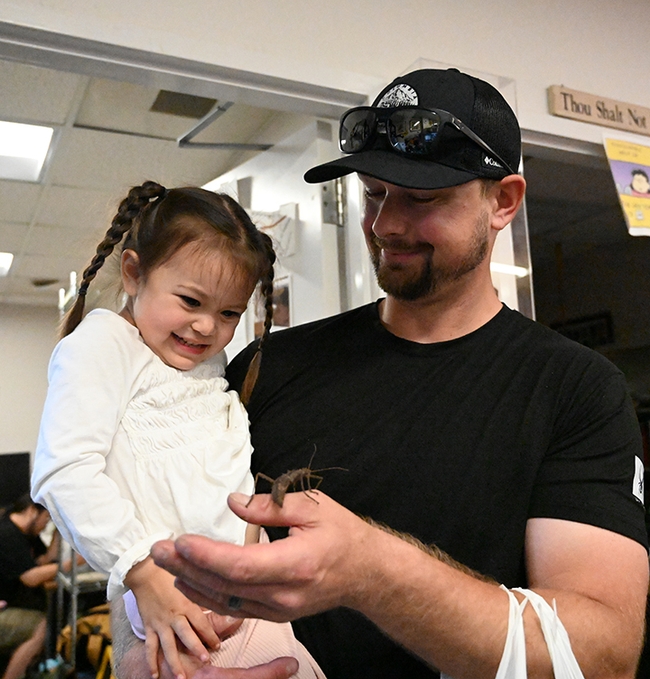
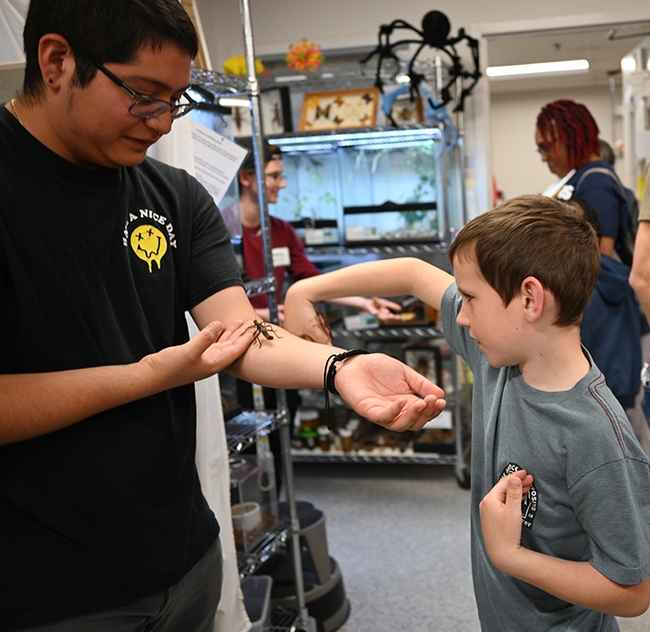
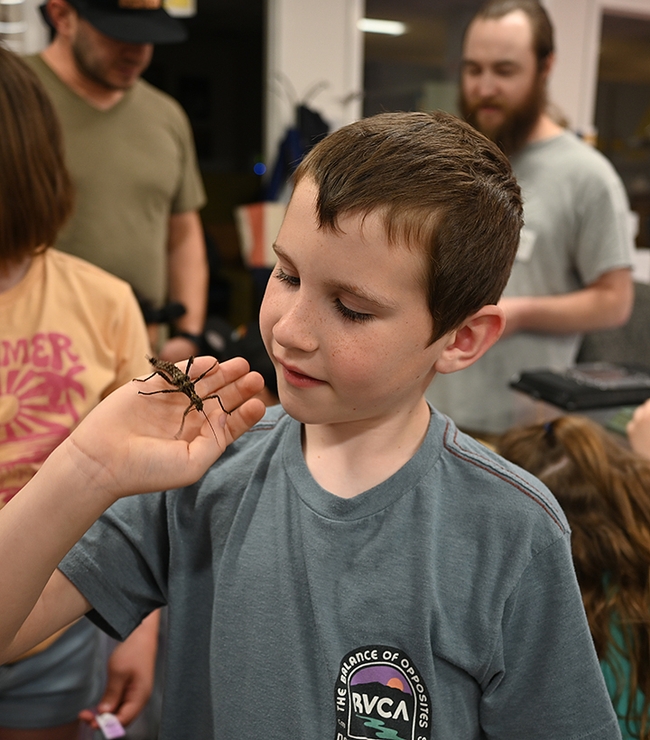
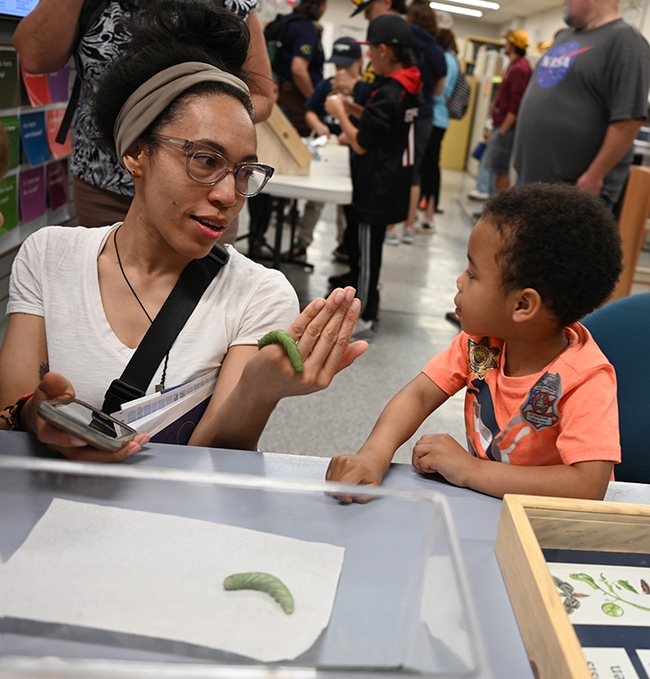
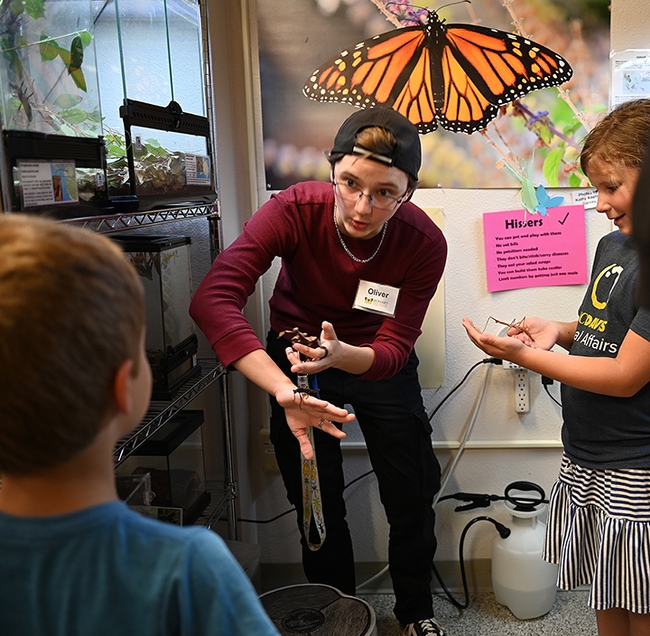
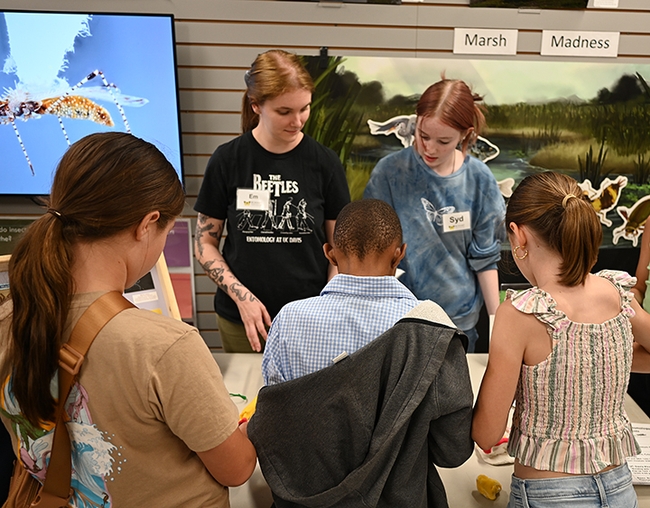
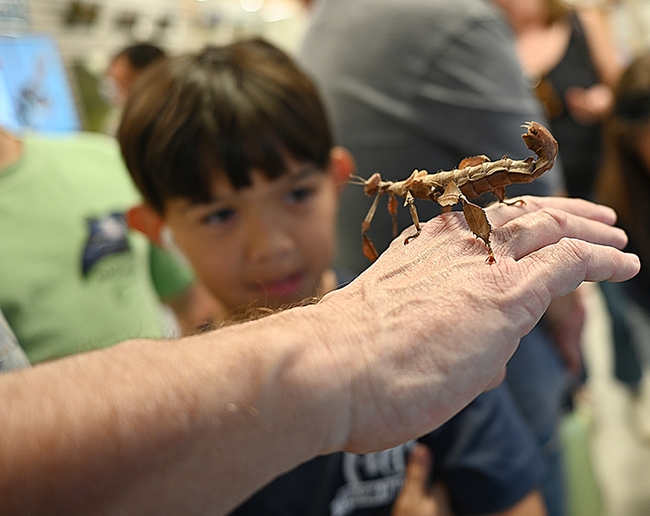
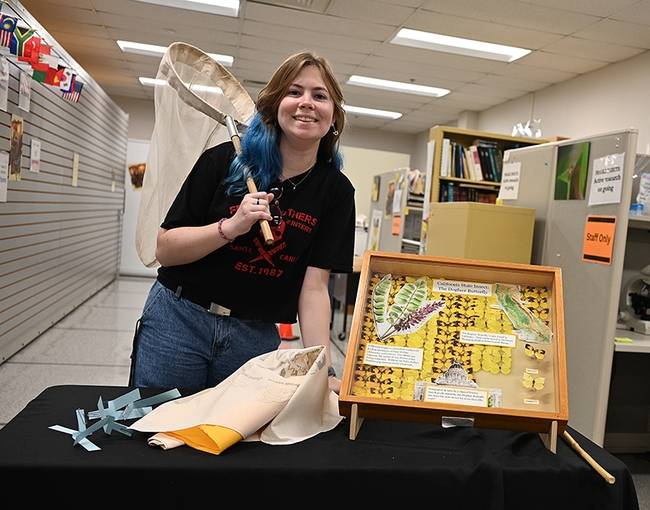
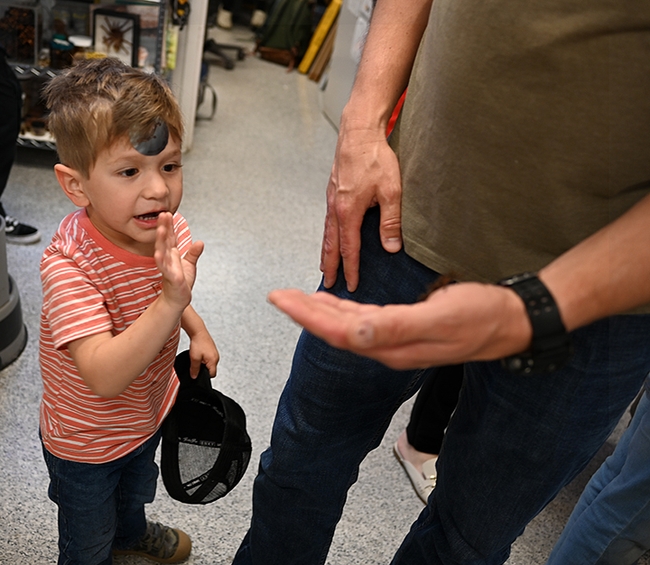
- Author: Kathy Keatley Garvey
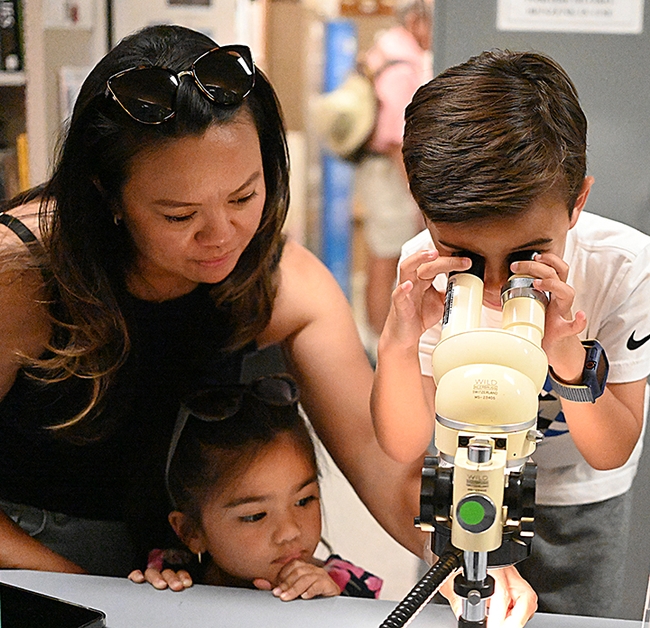
More than 300 attended the May 19th event, noted Tabatha Yang, education and outreach coordinator. They included residents of Yolo, Marin, Solano and Sacramento counties.
Community ecologist Rachel Vannette, associate professor and chair of the UC Davis Department of Entomology and Nematology, and three lab members--doctoral candidate Lexie Martin, doctoral student Dino Sbardellati, and junior specialist Leta Landucci--displayed nests of bumble bees, carpenter bees and solitary bees. They also invited visitors to examine live bee larvae under a microscope and engage in the interactive displays on the bee life cycle.
Others bee researchers participating:
- Bohart Museum bee scientists Thomas Zavortink and Sandy Shanks
- UC Davis graduate student Richard Martinez of the lab of apiculturist Elina Lastro Niño, associate professor of Cooperative Extension, UC Davis Department of Entomology and Nematology. He staffed the honey bee booth and answered questions about bees and beekeeping. He also displayed a bee observation hive (attendees eagerly tried to find the queen). Children and adults alike tried on the beekeeping suits and veils. He also discussed the apiary equipment, including a smoker and hive tools.
- Doctoral student Sofía Meléndez Cartagena of the Stacey Combes lab, Department of Neurobiology, Physiology and Behavior. She studies the diversity of bees and bee behavior.
- Doctoral student Peter Coggan of the laboratory of Chancellor's Fellow Santiago Ramirez, associate professor, Department of Evolution and Ecology. Coggan studies the neurological and genetic basis of orchid bee courtship behavior and evolution.
Brownie Troop 121 of Davis, led by co-leaders Dr. Jaclyn Watkins and Mel McClendon, attended. "We thought the event was fantastic!" said Watkins, associate professor of clinical pathology and residency program director, Department of Pathology and Laboratory. "Our girls also earned their Brownie Bug Badges by attending. They had a blast."
Bee specimens displayed ranged from honey bees and carpenter bees, to bumble bees and orchid bees, to leafcutter bees and sweat bees. Visitors also perused a number of bee books, including the newly published Honey Bee Biology, authored by Brian Johnson, associate professor, Department of Entomology and Nematology; and Calfornia Bees and Blooms: A Guide for Gardeners and Naturalists, published in 2014 and co-authored by Robbin Thorp (1933-2019), distinguished emeritus professor. California is home to more than 1600 species of undomesticated bees, most of them native, according to Thorp.
The Bohart Museum houses a global collection of eight million insects, plus a live petting zoo, and a gift shop. Professor Jason Bond directs the museum, succeeding Kimsey, who served 34 years until her retirement on Feb. 1. Bond is the Evert and Marion Schlinger Endowed Chair of the Department of Entomology and Nematology, and the associate dean, UC Davis College of Agricultural and Environmental Sciences. He also serves as president-elect of the American Arachnological Society.
The next open houses are set for
- Saturday, July 20: "Moth Night at the Museum," 7 p.m. to 11 p.m.
- Saturday, Sept. 28: "Museum ABCs: Arthropods Bohart, and Collecting," 1 to 4:30 p.m.
All open houses are free and family friendly; parking is also free on weekends.
Summer public walk-in hours are on Tuesdays, June 17-Aug. 27 from 9 a.m. to noon, and from 1 to 4 p.m. The museum will be closed to the general public from Sept. 1-22.
For more information, access the website at https://bohart.ucdavis.edu or contact bmuseum@ucdavis.edu.
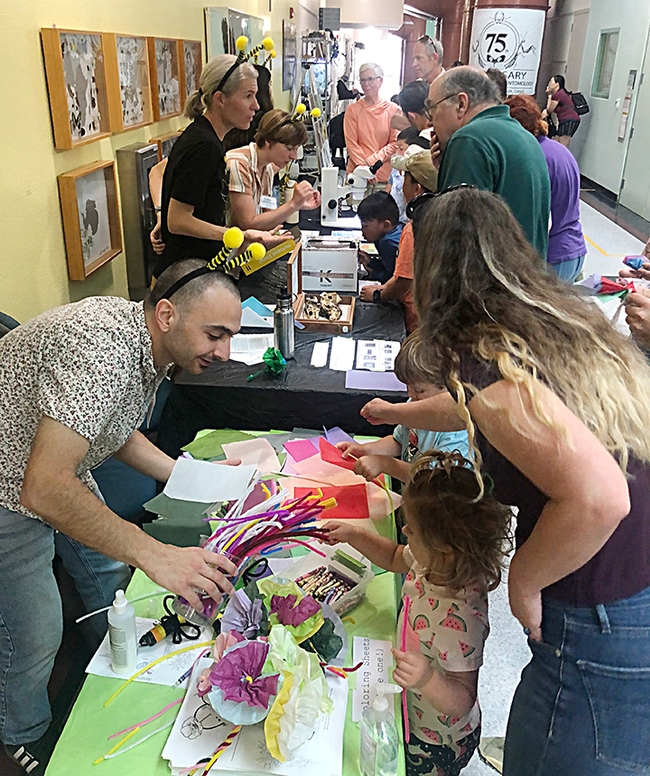
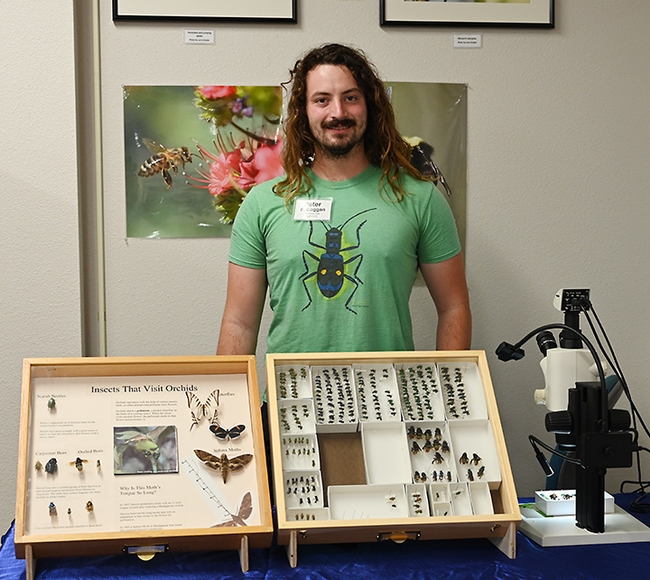
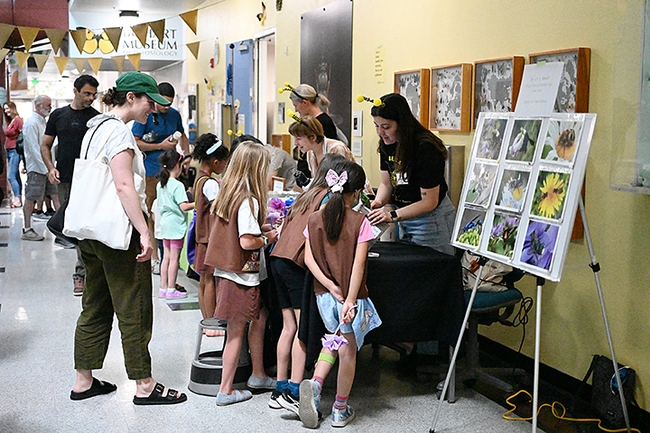
- Author: Kathy Keatley Garvey
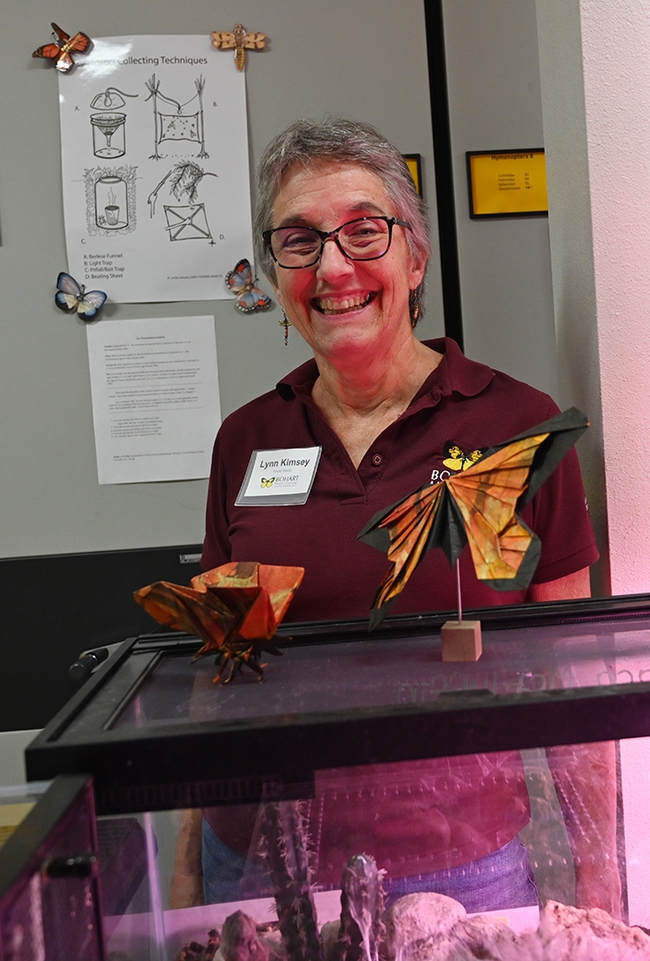
Western monarchs are now settling in their overwintering sites along coastal California, but the iconic butterflies showed up in force at the Bohart Museum of Entomology's recent open house--in the form of specimens, photographs, books, maps and displays.
Some 650 visitors arrived to talk to the scientists, see the displays, and take home native milkweed seed packets, provided by community ecologist Louie Yang, professor of entomology, UC Davis Department of Entomology and Nematology (ENT-NEM). Yang shared seeds of narrow-leafed milkweed, Asclepias fascicularis.
Statistics show that the overwintering population of western monarchs along coastal California has declined by more than 99 percent since the 1980s, according to the Xerces Society for Invertebrate Conservation, but the population has been showing a mini-boom in recent years. Scientists blame habitat destruction, pesticide use, and climate change as the primary causes of the decline.
Scientists participating in the open house were:
- UC Davis distinguished professor emeritus Art Shapiro of the Department of Evolution and Ecology, who has studied butterfly populations in central California since 1972 and maintains a research website, Art's Butterfly World.
- UC Davis emeritus professor Hugh Dingle, a worldwide authority on animal migration, including monarchs. He is the author of Migration: The Biology of Life on the Move (Oxford University Press), a sequel to the first edition published in 1996. (See news story on the ENT-NEM website.)
- UC Davis professor Louie Yang, who does research on monarchs and milkweed and has been featured nationally. (See news story about his work.)
- UC Davis professor Elizabeth Crone of the Department of Evolution and Ecology, formerly of Tufts University, who researches monarchs. (See news story about the declining monarch population on the ENT-NEM website.)
In addition, the Bohart Museum showcased monarch photography by Larry Snyder of Davis and Kathy Keatley Garvey of ENT-NEM.
Yang and Crone were among the 12 nationally invited scientists who delivered presentations during the two-day Monarch Butterfly Summit, held last year at the Capitol in Washington D.C. and organized by Sen. Jeffrey Merkley of Oregon, During that summit, the Department of the Interior announced a $1 million award to the National Fish and Wildlife Foundation's Monarch Butterfly and Pollinators Conservation Fund, and the U.S. Fish and Wildlife Service announced a Pollinator Conservation Center. (See news story)
In another project, Yang organized and led a three-year study of wild monarch butterflies and milkweed in rural Davis. The project, funded by two of Yang's National Science Foundation grants, involved UC Davis, Davis Senior High School and the Center for Land-based Learning, Woodland. The 135-member team included 107 high school students, a K-12 teacher, 18 UC Davis undergraduates, three graduate students and two postgraduate researchers.
"This study collected a high-resolution temporal dataset on milkweed-monarch interactions during the three years prior to the precipitous single-year population decline of western monarchs in 2018,” Yang said. From 2015 through 2017, the team monitored the interactions of monarchs, Danaus plexippus, on narrow-leafed milkweed, A. fascicularis, planted in December 2013 on city-owned property.
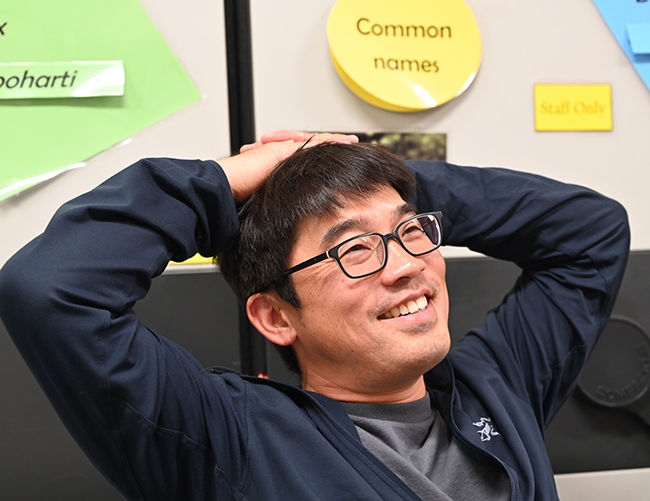
“This study has three key findings,” Yang related. “First, we documented early and late seasonal windows of opportunity in the wild, migratory western monarch population. Second, our data suggest that early and late seasonal windows were constrained by different factors. Third, climatic and microclimatic variation had a strong effect on the timing and importance of multiple factors affecting monarch development. Broadly, we hope that this study contributes to a more temporally detailed understanding of the complex factors that contribute to year-to-year variation in monarch breeding success.” (See news story on ENT-NEM website)
In February of 2022, Yang appeared on Science Friday, National Public Radio, in an interview titled "How Long Will California's Butterfly Boom Last?"
Hugh Dingle. Professor Dingle, an internationally known expert on animal migration, has researched animal migration for some 50 years. In the last two decades, he has focused on monarch butterflies. National Geographic featured him in its cover story on “Great Migrations” in November 2010. LiveScience interviewed him for its November 2010 piece on “Why Do Animals Migrate?”
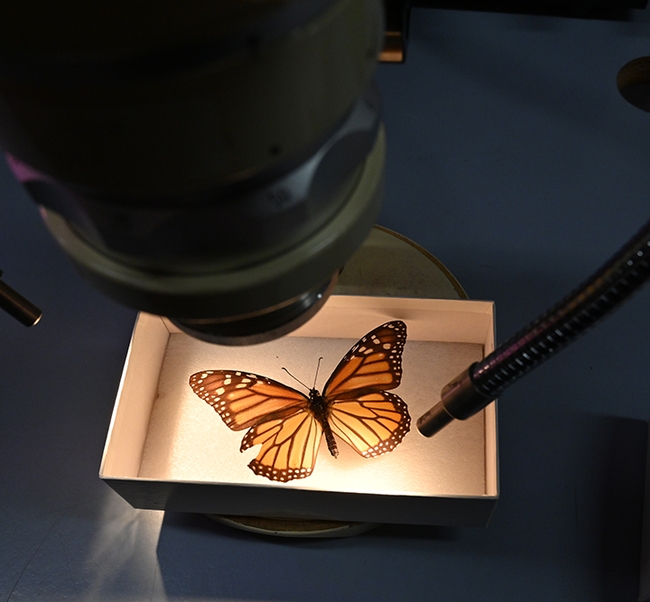
Dingle says:
- "There is not enough tropical milkweed planted to have much influence (see the amount of A. syriaca and A. fascicularis throughout the American West not to mention various other species like A. erosa, cordifolia, californica, etc.) Yes, there are parasites on A. curassavica as there are on ALL milkweeds."
- "There are populations of monarchs that are doing just fine feeding exclusively on A. curassavica (e.g. on many Pacific Islands, such as Guam where I have studied them."
- "Migration and the diapause that accompanies it in the fall are determined by shortening photoperiod and temperature (warm temps can override short days hence the issue with climate change). There is no significant influence of food plant."
Elizabeth Crone. Crone focuses her research on population ecology, "especially of plants and insects, and plant-animal interactions. Specifically, I am interested in how environmental changes translate to changes in population dynamics in animals. I was also one of the first ecologists to use generalized linear mixed models to parameterize stochastic population models." She co-authored "Why Are Monarch Butterflies Declining in the West? Understanding the Importance of Multiple Correlated Drivers," published in 2019 in Ecological Applications, Ecological Society of America.
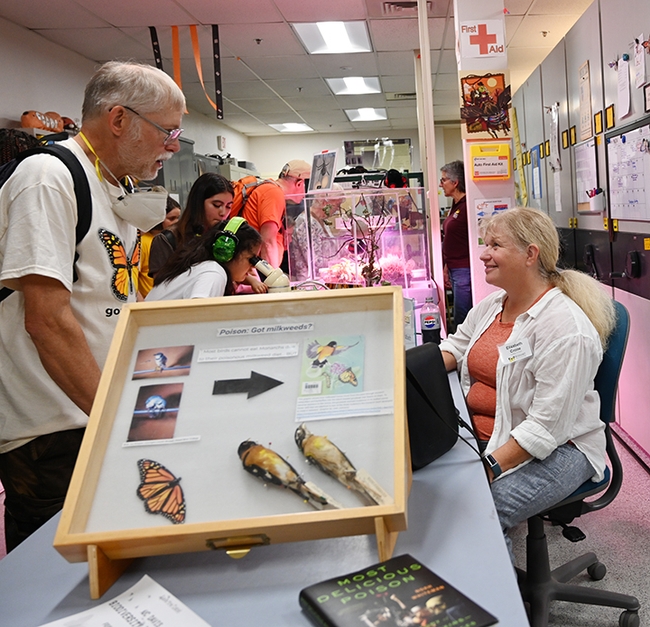
Art Shapiro. Professor Shapiro shared several handouts, including "Comments on Monarchs." He co-authored research (lead author Anne Espeset and six other colleagues) titled, "Understanding a Migratory Species in a Changing World: Climatic Effects and Demographic Declines in the Western Monarch Revealed by Four Decades of Intensive Monitoring," published in Population Ecology.
"None of my group is a Monarch specialist, and that includes me," Shapiro wrote in the handout. "Since 1999 I have done counts of all butterfly species at 4 Valley sites (Suisun, West Sacramento, North Sacramento and Rancho Cordova) using standard 'Pollard walk' methods, slightly modified. As a result we have a quantitative picture of Monarchs in breeding season over 14 years. Such data are very rare. Population estimates of Monarchs are typically based on the overwintering (non-breeding) aggregations and we know from published material that what breeding-season data exist routinely diverge from the overwintering data. That is, trends in population size as measured by overwinter animals are not routinely reflected in the summer numbers. There can be a variety of explanations for this. To me the most likely is that as a very mobile species, the Monarch may breed in different places in different years, so that a monitoring program like mine, based on a limited number of fixed, Intensively-monitored sites, is unlikely to capture this stochasticity in where Monarchs breed."
Over the last 50 years, "Suisun has had the highest counts (of monarchs), partly but not entirely reflecting coastward migration from farther inland early in the season, but these high numbers have effectively disappeared—perhaps reflecting a systematic change in migratory trajectories."
Also at the open house, entomologist Jeff Smith, who curates the Bohart's Lepidoptera collection, and colleague Greg Kareofelas showed visitors drawers of monarch and other butterfly specimens.
Two origami monarchs, the work of UC Davis alumnus Kevin Murakoshi of Davis and a gift to the Bohart Museum, drew special attention. Murakoshi earlier crafted origami praying mantises, ticks and bed bugs for Bohart Museum open houses.
One of the books displayed at the open house was UC Berkeley professor Noah Whiteman's newly published work, "Most Delicious Poison: The Story of Nature's Toxins--from Spices to Vices" (Little Brown Spark, Oct. 24, 2023) It includes information on the toxicity of milkweed.
The Bohart Museum, directed by UC Davis distinguished professor Lynn Kimsey, is located in Room 1124 of the Academic Surge Building, 455 Crocker Lane, UC Davis campus. It is the home of a global collection of eight million insect specimens. It also houses a live "petting zoo" (including Madagascar hissing cockroaches, stick insects and tarantulas) and a gift shop.
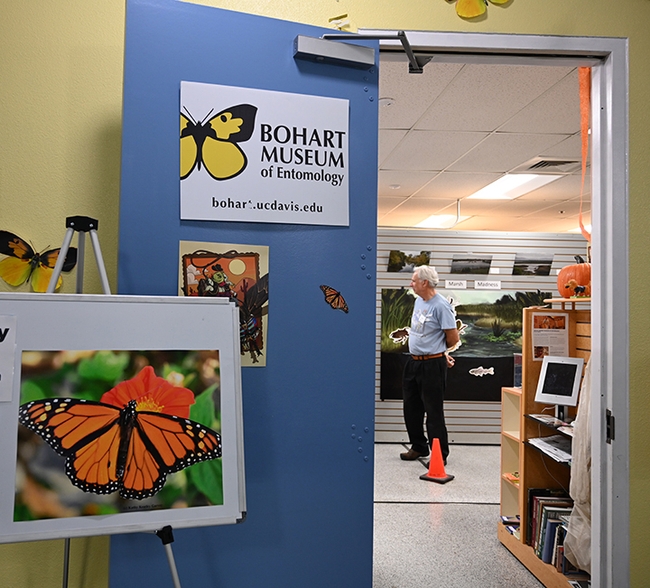
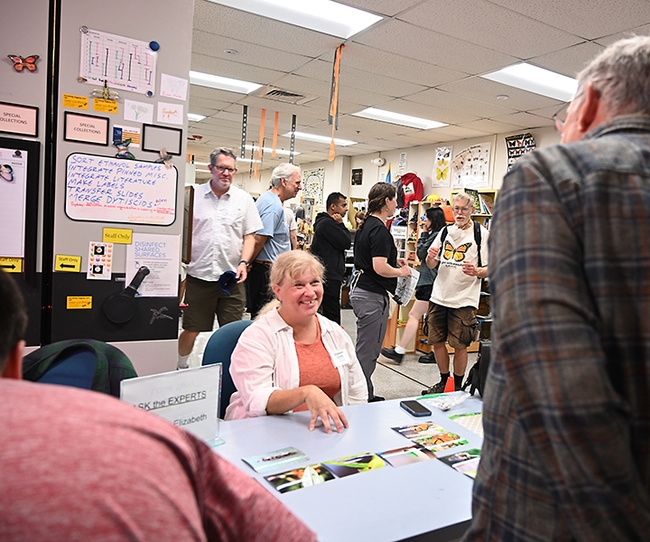
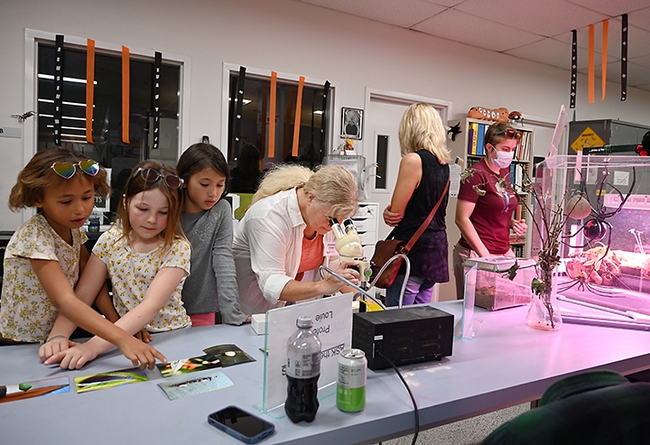
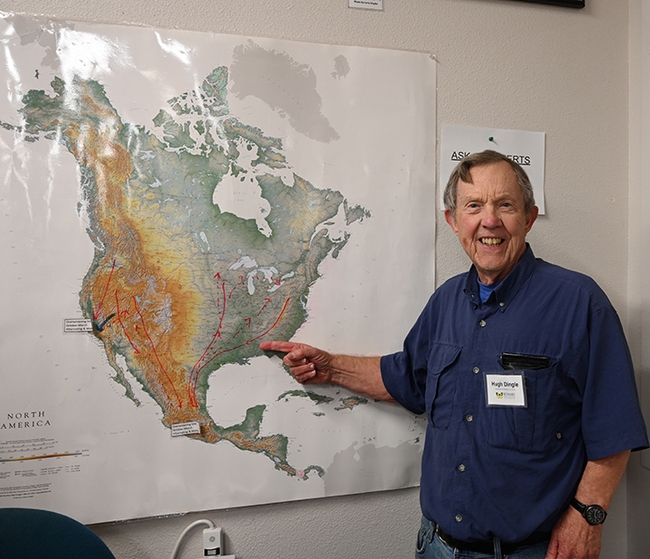
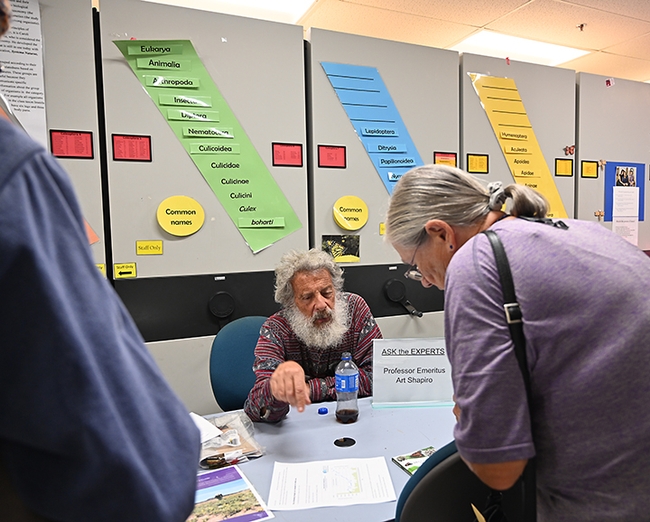
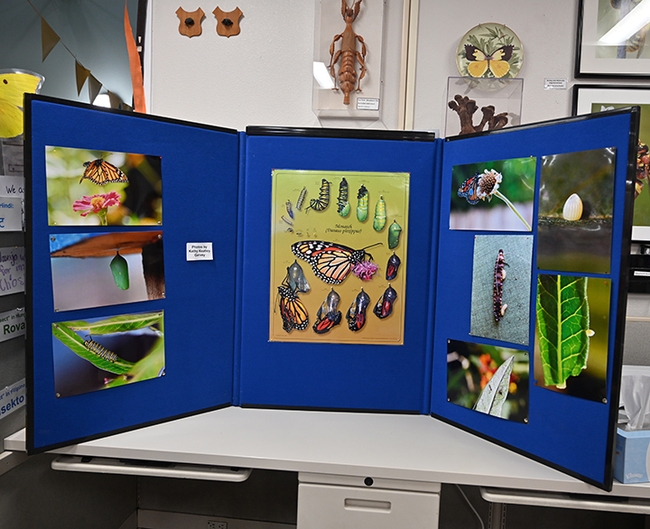
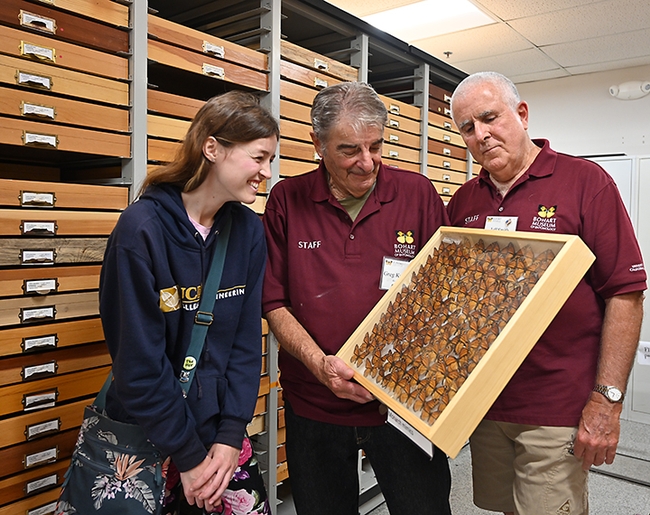
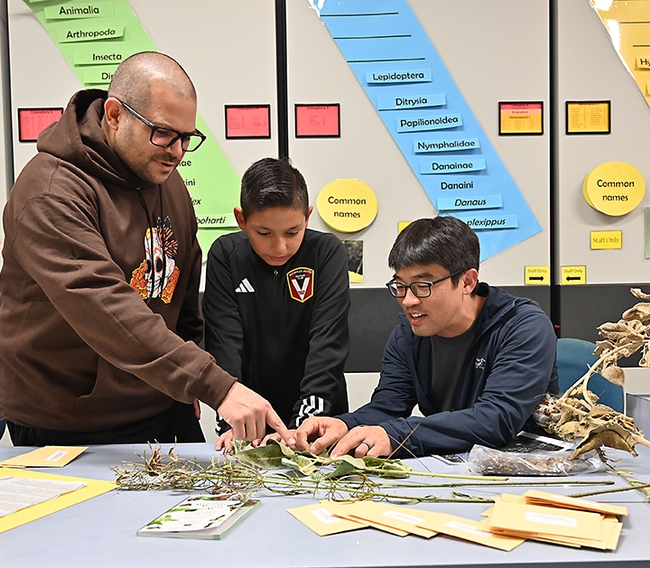
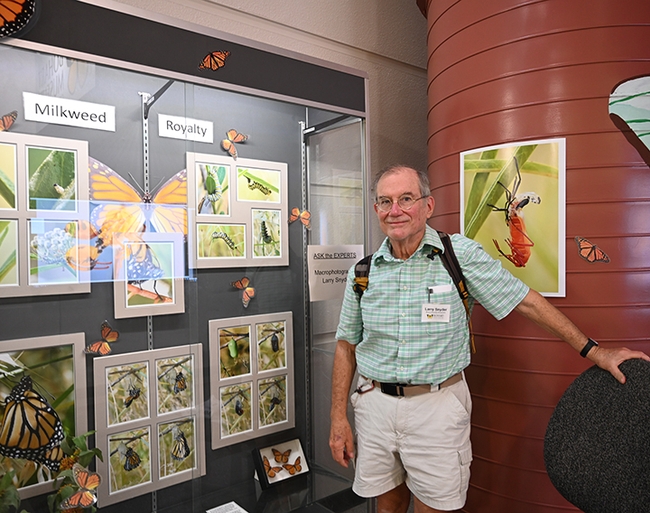
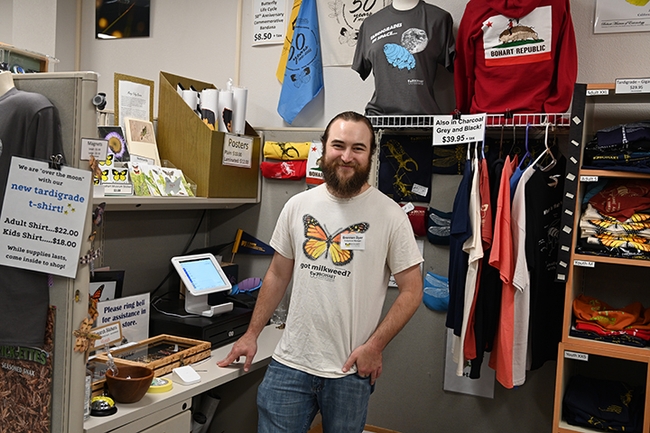
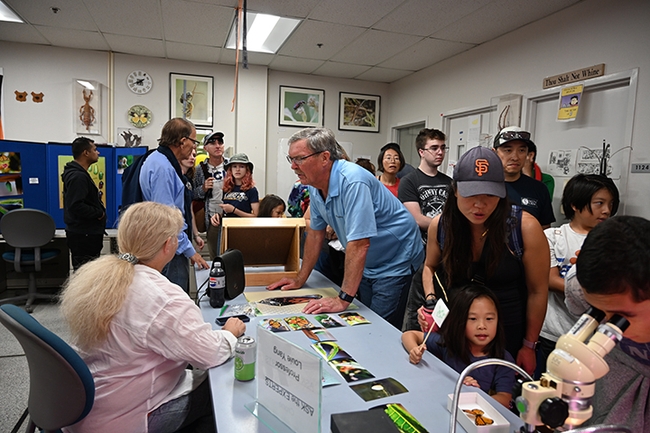
- Author: Kathy Keatley Garvey
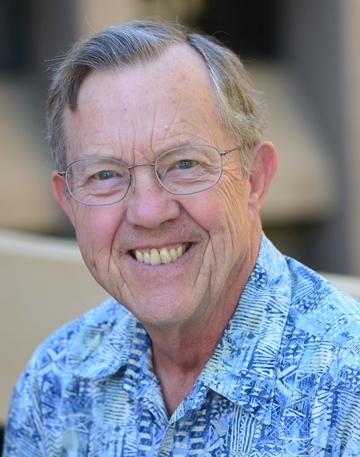
No, say many scientists, including Hugh Dingle, professor emeritus of entomology, behavior and evolution at UC Davis.
Professor Dingle is an internationally known expert on animal migration. He's researched animal migration for some 50 years. In the last 20 years or so, he has focused on monarch butterflies. He has authored two editions of Migration: The Biology of Life on the Move and some 100 papers. National Geographic featured Professor Dingle in its cover story on “Great Migrations” in November 2010. LiveScience interviewed him for its November 2010 piece on “Why Do Animals Migrate?” (See news story that includes his biographical information)
Professor Dingle, a resident of Marin County, responded to a recent front-page article in a Marin County paper about the California ban on tropical milkweed. Banning tropical milkweed, A. curassavica, will NOT save the monarch, Dingle emailed the reporter. In fact, he said, the ban will "essentially have zero effect on monarchs" and "no one should rush out and pull out their tropical milkweed as it would be a waste of time and effort. Nurseries should also be able to continue to sell it."
The professor shared this with Bug Squad:
- "There is not enough tropical milkweed planted to have much influence (see the amount of A. syriaca and A. fascicularis throughout the American West not to mention various other species like A. erosa, cordifolia, californica, etc.) Yes, there are parasites on A. curassavica as there are on ALL milkweeds."
- "There are populations of monarchs that are doing just fine feeding exclusively on A. curassavica (e.g. on many Pacific Islands, such as Guam where I have studied them."
- "Migration and the diapause that accompanies it in the fall are determined by shortening photoperiod and temperature (warm temps can override short days hence the issue with climate change). There is no significant influence of food plant."
Tropical milkweed has been in California for more than a century. It's along our roadsides, in our parks, in our gardens. If the California border were moved a bit, it would be a native plant. Yet the California Department of Food and Agriculture, influenced by native plant proponents, has deemed it a "noxious weed."
Professor Dingle is among many scientists who point out that milkWEED (despite the "weed" in its name), is NOT a noxious plant. If you're standing on the California-Mexico border, on one side it's a noxious weed (evil, dangerous, nasty, get-rid-of-it-now, how-dare-you) and inches away, it's a beautiful host plant for monarchs, and a great nectar source for monarchs and other pollinators, including honey bees, syrphid flies and hummingbirds.
The California Department of Fish and Wildlife's ban on rearing monarchs (no one can do so without a permit) is unsettling to many. Entomologist Jeff Smith, who curates the Lepidoptera collection at the Bohart Museum of Entomology at UC Davis and is a member of the Lepidopterists' Society, reared a few monarchs as a child, but laments that today, no one in California can do so without a permit, and it's difficult to get a permit unless you're a researcher.
In the latest edition of the Lepidopterists' Society newsletter, Robert Michael Pyle (founder of the Xerces Society for Invertebrate Conservation) and David Wagner wrote a piece, "Keep Nets in the Hands of Kids--and Others!"
An excerpt: "Give a kid a net, and watch her go! Not that the net is the only porthole into our world. For some it could be raising caterpillars or tadpoles, keeping mantises and walking sticks as pets, or examining ants, beetles, and grass- hoppers through a magnifying glass. But the common feature is having hands-on, unfettered exploration of the living world as children. Many life-science professionals, including RMP's cardiologist, ascribe their passion for life and nature to hunting bugs, crawdads, and pollywogs in their youth. This is why the Society instituted the Outernet Project, to get nets into the hands of children—a task made more difficult not only by the umbilical USB connection now present at birth and children's subsequent inseparability from electronica, but also by the loss of BioQuip. Is the coup de grâce for children's face-to-face fascination with small-scale life to be delivered now by well-intended but ill-considered regulation?"
So Very Controversial. Amazing that tropical milkweed issue has become so very controversial. You cannot post an image of a egg, caterpillar, chrysalis or a monarch on A. curassavica--a food and nectar source--without a native plant proponent attacking you and ordering you to remove that tropical plant in your garden immediately. (Never mind that you are growing native milkweed as well.) One scientist told me: "They just want to control you and bully you."
In our pollinator garden in Vacaville, monarchs prefer tropical milkweed over the non-natives. Tropical is more toxic.
Mona Miller, who administers the popular Facebook page, Creating Habitat For Butterflies, Moths, & Pollinators, related: "Monarch are resilient insects, they have so many strategies to increase their population, but they do have their limits. We must stop pulling out tropical milkweed and cutting it back. Washing off all milkweed should suffice to clean off the OE spores. I emailed several scientists, no one could tell me that OE (Ophryocystis elektroscirrha is a protozoan parasite) has any way to attach to milkweed leaves other than getting caught in the hairs. Tropical milkweed has smooth leaves. Tropical milkweed has been in California since 1909, that is over 100 years. Totally eradicating tropical milkweed, just like totally eradicating all the eucalyptus trees (non-natives), would have a detrimental effect on the monarch population--perhaps it already has."
Indeed, folks should pay more attention to habitat loss and pesticide use, the real culprits of the monarch population decline.
Bohart Museum Open House. At any rate, be sure to attend the Bohart Museum of Entomology's open house on monarchs from 1 to 4 p.m., Saturday, Nov. 4 in Room 1124 of the Academic Surge Building, 455 Crocker Lane, UC Davis. It's free and family friendly. A number of scientists will be there to answer your questions.
Scheduled to participate are:
- UC Davis distinguished professor emeritus Art Shapiro of the Department of Evolution and Ecology, who has studied butterfly populations in central California since 1972 and maintains a research website, Art's Butterfly World.
- UC Davis emeritus professor Hugh Dingle, a worldwide authority on animal migration, including monarchs. He is the author of Migration: The Biology of Life on the Move (Oxford University Press), a sequel to the first edition published in 1996. See news story on the UC Davis Entomology and Nematology website.
- UC Davis professor Louie Yang, who does research on monarchs. Due to parental duties, he may be able to attend only the last part of the open house. See news story about his work.
- UC Davis professor Elizabeth Crone of the Department of Evolution and Ecology, formerly of Tufts University, who researches monarchs. See news story about the declining monarch population on the UC Davis Entomology and Nematology website.
The Bohart Museum houses a global collection of eight million insect specimens, plus a living insect petting zoo (Madagascar hissing cockroaches and stick insects, among others), and a insect-themed gift shop. UC Davis distinguished professor Lynn Kimsey has directed the Bohart Museum, founded in 1946, since 1990.
